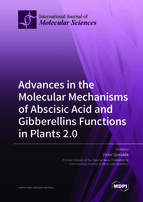Advances in the Molecular Mechanisms of Abscisic Acid and Gibberellins Functions in Plants 2.0
A special issue of International Journal of Molecular Sciences (ISSN 1422-0067). This special issue belongs to the section "Molecular Plant Sciences".
Deadline for manuscript submissions: closed (30 June 2022) | Viewed by 38333
Special Issue Editor
Interests: genetics; plant development; abiotic stress; arabidopsis; chloroplast biogenesis; mTERF; organelle gene expression
Special Issues, Collections and Topics in MDPI journals
Special Issue Information
Dear Colleagues,
This Special Issue is the continuation of our previous special issue "Advances in the Molecular Mechanisms of Abscisic Acid and Gibberellins Functions in Plants".
Gibberellins (GA) and abscisic acid (ABA) are two phytohormones that regulate in an antagonistic way, plant growth as well as several developmental processes from seed maturation and germination to flowering time, through hypocotyl elongation and root growth. In general, ABA and GA inhibit and promote respectively, cell elongation and growth. Consequently, this mutual antagonism between GA and ABA governs many developmental decisions in plants.
In addition to its role as growth and development modulator, ABA is primarily known for being a major player in the response and adaptation of plants to diverse abiotic stress conditions, including cold, heat, drought, salinity or flooding. Remarkably, different works have also recently pointed to a function for GA in the control of some biological processes in response to stress.
This Special issue will focus on the most recent advances in ABA and GA functions in the regulation of plant growth, development as well as in the response to abiotic stress. The submission of works reporting ABA and GA crosstalk, as well as the integration of GA and ABA action with other plant hormones and/or environmental cues are especially encouraged. Notwithstanding, contributions on other related topics aimed at understanding the molecular mechanisms of ABA and/or GA action in plants are also welcomed, including reviews and original research articles.
Prof. Dr. Víctor Quesada
Guest Editor
Manuscript Submission Information
Manuscripts should be submitted online at www.mdpi.com by registering and logging in to this website. Once you are registered, click here to go to the submission form. Manuscripts can be submitted until the deadline. All submissions that pass pre-check are peer-reviewed. Accepted papers will be published continuously in the journal (as soon as accepted) and will be listed together on the special issue website. Research articles, review articles as well as short communications are invited. For planned papers, a title and short abstract (about 100 words) can be sent to the Editorial Office for announcement on this website.
Submitted manuscripts should not have been published previously, nor be under consideration for publication elsewhere (except conference proceedings papers). All manuscripts are thoroughly refereed through a single-blind peer-review process. A guide for authors and other relevant information for submission of manuscripts is available on the Instructions for Authors page. International Journal of Molecular Sciences is an international peer-reviewed open access semimonthly journal published by MDPI.
Please visit the Instructions for Authors page before submitting a manuscript. There is an Article Processing Charge (APC) for publication in this open access journal. For details about the APC please see here. Submitted papers should be well formatted and use good English. Authors may use MDPI's English editing service prior to publication or during author revisions.







